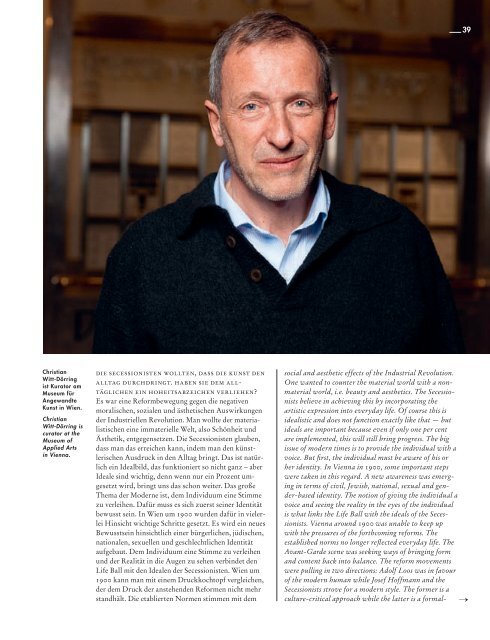Create successful ePaper yourself
Turn your PDF publications into a flip-book with our unique Google optimized e-Paper software.
39<br />
Christian<br />
Witt-Dörring<br />
ist Kurator am<br />
Museum für<br />
Angewandte<br />
Kunst in Wien.<br />
Christian<br />
Witt-Dörring is<br />
curator at the<br />
Museum of<br />
Applied Arts<br />
in Vienna.<br />
die secessionisten wollten, dass die kunst den<br />
alltag durchdringt. haben sie dem alltäglichen<br />
ein hoheitsabzeichen verliehen?<br />
Es war eine Reformbewegung gegen die negativen<br />
moralischen, sozialen und ästhetischen Auswirkungen<br />
der Industriellen Revolution. Man wollte der materialistischen<br />
eine immaterielle Welt, also Schönheit und<br />
Ästhetik, entgegensetzen. Die Secessionisten glauben,<br />
dass man das erreichen kann, indem man den künstlerischen<br />
Ausdruck in den Alltag bringt. Das ist natürlich<br />
ein Idealbild, das funktioniert so nicht ganz – aber<br />
Ideale sind wichtig, denn wenn nur ein Prozent umgesetzt<br />
wird, bringt uns das schon weiter. Das große<br />
Thema der Moderne ist, dem Individuum eine Stimme<br />
zu verleihen. Dafür muss es sich zuerst seiner Identität<br />
bewusst sein. In Wien um 1900 wurden dafür in vielerlei<br />
Hinsicht wichtige Schritte gesetzt. Es wird ein neues<br />
Bewusstsein hinsichtlich einer bürgerlichen, jüdischen,<br />
nationalen, sexuellen und geschlechtlichen Identität<br />
aufgebaut. Dem Individuum eine Stimme zu verleihen<br />
und der Realität in die Augen zu sehen verbindet den<br />
<strong>Life</strong> <strong>Ball</strong> mit den Idealen der Secessionisten. Wien um<br />
1900 kann man mit einem Druckkochtopf vergleichen,<br />
der dem Druck der anstehenden Reformen nicht mehr<br />
standhält. Die etablierten Normen stimmen mit dem<br />
social and aesthetic effects of the Industrial Revolution.<br />
One wanted to counter the material world with a nonmaterial<br />
world, i.e. beauty and aesthetics. The Secessionists<br />
believe in achieving this by incorporating the<br />
artis tic expression into everyday life. Of course this is<br />
idealistic and does not function exactly like that — but<br />
ideals are important because even if only one per cent<br />
are implemented, this will still bring progress. The big<br />
issue of modern times is to provide the individual with a<br />
voice. But first, the individual must be aware of his or<br />
her identity. In Vienna in 1900, some impor tant steps<br />
were taken in this regard. A new awareness was emerging<br />
in terms of civil, Jewish, national, sexual and gender-based<br />
identity. The notion of giving the individual a<br />
voice and seeing the reality in the eyes of the individual<br />
is what links the <strong>Life</strong> <strong>Ball</strong> with the ideals of the Secessionists.<br />
Vienna around 1900 was unable to keep up<br />
with the pressures of the forthcoming reforms. The<br />
established norms no longer reflected everyday life. The<br />
Avant-Garde scene was seeking ways of bringing form<br />
and content back into balance. The reform move ments<br />
were pulling in two directions: Adolf Loos was in favour<br />
of the modern human while Josef Hoffmann and the<br />
Secessionists strove for a modern style. The former is a<br />
culture-critical approach while the latter is a formal-<br />
→


